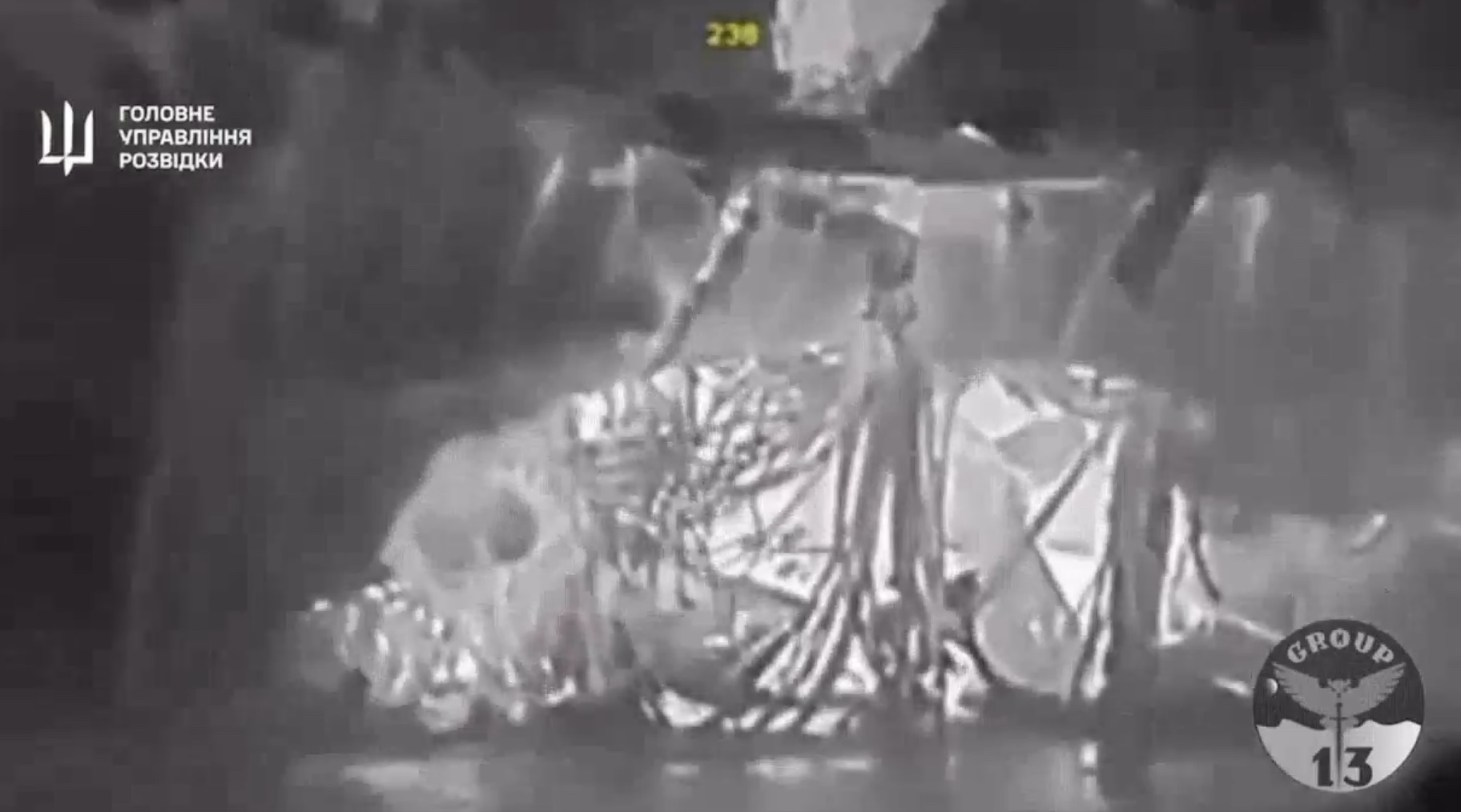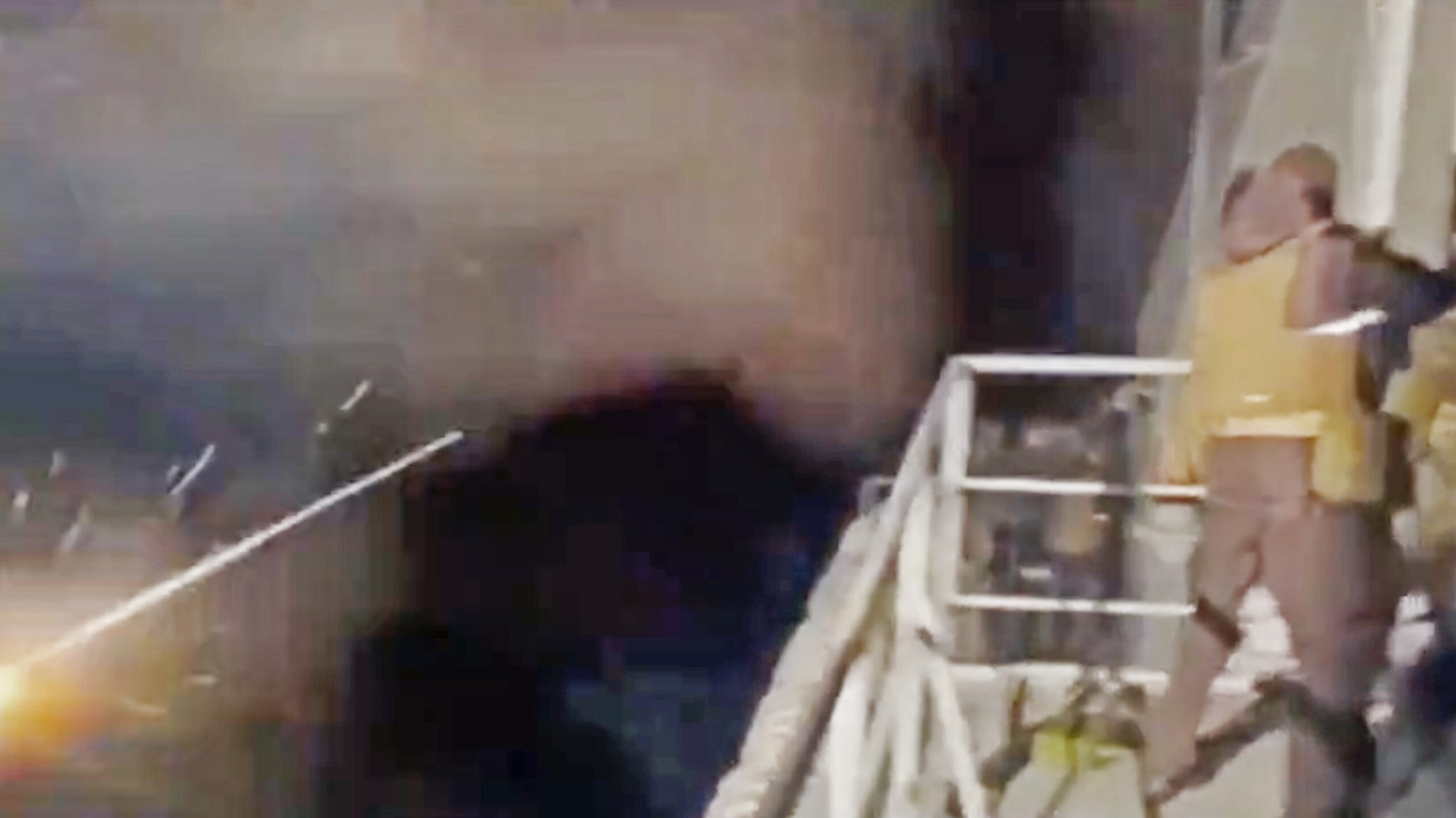An extraordinary video has emerged showing some of the last moments aboard the Russian Black Sea Fleet landing ship Cesar Kunikov (also written as Tsezar Kunikov) as it was attacked by Ukrainian naval drones last month. The sinking of the Ropucha class landing ship by MAGURA V5 uncrewed surface vessels (USVs) was no secret, but the latest footage is the most dramatic to have emerged so far from the Russian perspective of the ‘drone boat war’ in the Black Sea. It also underscores just how challenging defending against such an attack, especially by multiple drone boats at once, can be.
Running to a length of nearly three minutes, the video, which began to circulate widely on social media channels today, appears to have been taken by one of the ship’s crew members. Using a GoPro-like camera, they recorded the efforts to engage the incoming drones using gunfire, the night sky periodically lit up by tracer rounds ricocheting off the water. In particular, one crewman close to the camera uses a light machine gun in an ultimately vain effort to take out the drone boats. At around the 1:40 mark in the video below, which includes partial audio, the ship is lit up by a major explosion, as one of the USVs impacts or the result of a secondary detonation.
According to a Russian account of the attack, shared on some of the same channels:
“The crew repelled the naval kamikaze drone attack with all available forces and means, the battle lasted 20 minutes. Of the 10 drones, [the first] four were destroyed. The fifth drone hit the ship in the stern, thereby immobilizing the ship, after which the sixth, seventh, eighth, and ninth drones alternately hit the ship on the port side in the midship area (middle) and closer to the stern, with the aim of capsizing the ship (due to the influx of a large amount of water from one side). The ninth drone partially entered the hole made by the previous one and detonated almost inside of the ship.”
“There was no way to save the ship (the list was rapidly increasing [and] the ship was lying on the left side). From the moment the enemy drones were discovered and the start of the battle, until the ship was completely flooded, a little more than 40 minutes passed. The crew left the ship using life rafts, without loss of personnel and evacuated all secret documentation and part of the secret equipment with weapons. The last, tenth drone monitored the dying ship until the sinking, after which the tenth drone tried to attack the accompanying tug but was destroyed by the group on board.”
The War Zone is not able to verify the accuracy of this account, but it makes for an interesting comparison with a video and statements from Ukrainian officials about the attack on the Cesar Kunikov, which took place on the night of February 14-15.
In the video released soon after the incident by the Ukrainian Main Directorate of Intelligence (GUR), seen below, several USVs are seen heading toward the vessel and a huge detonation, after which the superstructure is seen ablaze.
At one point in the GUR video, some of the warship’s crew are visible on deck and there appear to be splashes from small-arms fire near one of the boats as it gets very close to its target. The GUR video ends with the ship lying on its side, its superstructure facing toward the relevant camera — mounted on the tenth drone, according to the Russian account.
Local reports described residents in Crimea hearing five explosions, which tallies with both the Russian account and a statement to The War Zone from Lt. Gen. Kyrylo Budanov, head of the GUR, who said that five USVs hit the landing ship.
Whether all the crew managed to escape the vessel remains unclear, despite the claims in the Russian account. The GUR said that the Russian search and rescue operation “was unsuccessful,” although provided no more details about this.
Interestingly, soon after the incident, the Russian Ministry of Defense claimed that it had destroyed six drones in the Black Sea the same night that the Cesar Kunikov was sunk. This compares with the five USVs claimed destroyed by the newer, unofficial Russian account, although it remains possible that one Ukrainian may have been destroyed in a separate encounter. Still, the numbers are very close.

The video and the description also underscore just how well planned and coordinated these attacks have become, with elements of the pack of USVs distracting the crew while others repeatedly target one specific vulnerability point on the ship’s hull. This is a tactic we have seen repeatedly, especially since the loss of the Caesar Kunikov.
Most importantly, however, the loss of the Cesar Kunikov emphasized the continued vulnerability of the Black Sea Fleet to Ukrainian operations, especially those involving naval drones.
The attack on the Cesar Kunikov was the second successful operation of its kind conducted by Ukraine in the Black Sea last month. On February 1, the Tarantul III class missile corvette Ivanovets was destroyed in another drone attack, which you can read about here.

Only yesterday, meanwhile, another Black Sea Fleet vessel was confirmed sunk, the latest victim being the Project 22160 patrol ship Sergei Kotov. You can read all about this incident here.
On all three occasions, Maritime Autonomous Guard Unmanned Robotic Apparatus (MAGURA V5) drones are said to have been used by the Ukrainians.

As we have previously reported, the Ukrainian-developed MAGURA V5 is 18 feet long, with a range of 450 nautical miles, a cruising speed of 22 knots, and a burst speed of 42 knots. It features waterjet propulsion and a streamlined hull, and it can carry a payload of 705 pounds. The manufacturer says it communicates via mesh radio with an air-based repeater and/or SATCOM.
A CNN report on the Ukrainian USV program including footage showing the MAGURA V5:

The exact cost of each of these USVs is not known but is likely in the region of tens to the low hundreds of thousands of dollars. This implies a very high rate of return when tasked against major naval vessels, even with unsuccessful operations factored in. The Sergei Kotov alone was reportedly worth around $65 million, according to claims from the GUR.
Obviously, the Ukrainian effort directed against the Black Sea Fleet is proving highly successful. While this is a reality recognized by Russian and Ukrainian military bloggers alike, so far, at least, the Russian Navy seems to have done little to effectively mitigate the hazards it faces in these waters.
Generally, the close-in weapon systems on some of the Russian vessels that have been attacked appear to be less than effective against these novel threats.
Russia has begun using helicopters, among other aircraft, in efforts to hunt down Ukrainian naval drones in waters around Crimea, but the growing tally of ships sunk suggests these operations have not been especially effective.
It seems that Moscow may have also dismissed the commander of the Black Sea Fleet, Admiral Viktor Sokolov, in mid-February, in response to the heavy losses. This is according to an assessment today from the U.K. Ministry of Defense.
This latest video, which vividly depicts the grim reality of a surface vessel coming under attack from what is a still novel threat — and the desperate, ineffective measures taken to try and defend the warship — might finally prompt a different approach from the Russian Navy. At the same time, the video highlights just how challenging it is to defend against a highly coordinated, multiple USV attack.
Contact the author: thomas@thewarzone.com
